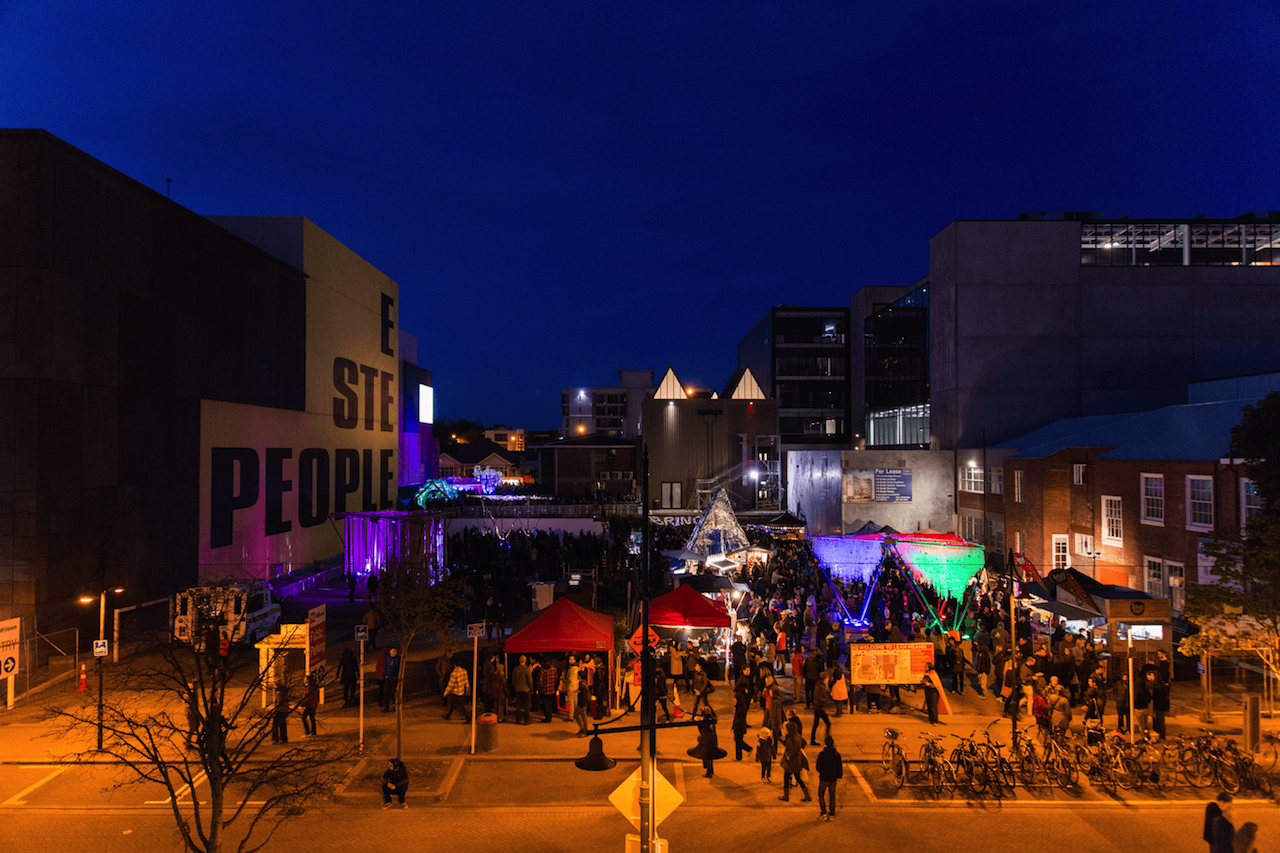Lean Means at FESTA: The Festival of Transitional Architecture 2016
A review of Lean Means, FESTA, 22 October 2016. Submitted to Communication Design: Interdisciplinary and Graphic Design Research
article by Jo Bailey and Nick Kapica
In the aftermath of the devastating Christchurch earthquake of 2011, FESTA was born. FESTA is Christchurch’s Festival of Transitional Architecture, initiated in 2012 as a way to reimagine a city in flux, finding its feet and redefining its spaces. The first FESTA was a nighttime light show and street party; a moment of joy and wonder that helped reconnect people, through a shared moment, with the city centre; socialising and social bonding. It was so successful it became an annual event. Five years on from the quake, much has changed for Christchurch, but much change is still embryonic. FESTA is as needed now as it ever was, though the emphasis has shifted from surviving, to thriving for the long term.
The festival is curated by Te Pūtahi – Christchurch centre for architecture and city-making, a non-profit focused on the current rebuild and ongoing renewal of the city for the long term. In 2016 FESTA shifted to from annual to biannual, and the headline event on 22 October was Lean Means – a night of installation and celebration framed around exploring sustainability through the reuse of waste materials in design and creative urban regeneration.
The creative director was Jos de Krieger of Superuse Studios (Netherlands). De Krieger is renowned for architecture, urban installation and intervention informed by the availability of leftover and waste materials, utilising these to push architecture and design into a closed-loop, cyclical process. Lean, practical, but with a playful exuberance, de Krieger’s oeuvre is a great fit for FESTA (churlish thoughts on the carbon footprint implications of flying a Dutchman to Christchurch aside), especially when coupled with the pragmatic, dynamic force of nature that is Dr Jessica Halliday, art and architectural historian and FESTA’s director. There is part of the New Zealand’s cultural lexicon that claims – because of our isolation and relative youth as a nation – Kiwis have a notable ingenuity (our famed ‘number 8 wire’ mentality – a fix it up, make-do-and mend, get inventive attitude named for a gauge of fencing wire that was ubiquitous here). Kiwis would have you believe we are uniquely inventive with what’s at hand, and The ‘Superuse’ practice and ethos de Krieger imbued into the festival actually gives legitimacy and credence to this somewhat overused maxim. Another form of regenerating and recycling! This emphasis on reuse in a city where – despite the efforts of groups such as Rekindle (a social enterprise seeking to divert reusable materials from waste) – much of the post-quake demolition material went into landfill is apt, and a logical evolution as Christchurch becomes focused on long term viability, thriving over surviving.
The city still knows how to revel in the joie de vivre of its very existence, and Lean Means was a joyful moment of celebrating collectively in a city centre still missing buildings like a gappy smile. A vibrant street party of food, music, performance and 18 installations, all assembled by educational institutions from across Australasia from waste materials. A waterfall of bottles and plastic bags lit with LEDS (Fallingwater, Unitec, Department of Architecture); a fence tunnel woven by visitors with waste fabric to become an intriguing knitted obstacle course (No Offence, Auckland University of Technology, Spatial Design); an ethereal cloud of plastic bags (Cumulonimbus, University of Adelaide, School of Architecture and Built Environment); a temporary village of woven hazel structures (Hence, Ara, School of Architectural Studies in collaboration with craft artist Juliet Arnott (Rekindle)) and a landscape of suspended cardboard carpet tubes, lit with projected material explorations (Pipe Dreaming, Massey University School of Design in collaboration with artist Julia Morison) were a few of the diverse sculptural pavilions on display.
Working with tertiary institutions is a win-win situation for FESTA and the schools involved. FESTA get managed manpower to deliver a diversity of forms, and the student teams get exposed to ‘real’ problems: strict site management requirements, engineers, council sign-off processes, and of course gain from the input of de Krieger and the FESTA team. For past events, design teams have been drawn from architecture or spatial design courses exclusively, but this year, FESTA extended the invitation to a team from Massey University that was open to all design disciplines (and was, in line with the makeup of the school, skewed towards visual communication). The Massey students were empowered to consider what they as individuals could contribute; not specifically the skills from ‘their discipline’. Students commented that this helped them with new ways of thinking; a Spatial Design student summed this up: “previous projects I’ve done in spatial design, because we are all thinking in the same way, approaching the issues from the same perspective, it was more difficult to get over a hurdle”. Another insight was that approach broadened their perspective and that this was liberating. This from a Visual Communication student: “It has completely expanded our view of university, completely expanded our resources rather than limiting them because of what we are called as designers; our label”. In addition to the interdisciplinary design approach, artists acted as both ‘clients’ and mentors to two of the teams. This melding of art and design, and, in a broad sense, of design disciplines offered an interesting added dimension, and this exploration of interdisciplinarity could become a more deliberate, experimental part of the FESTA offering in future years.
FESTA’s evolution from a format to revitalise the spirits and re-engage a community with their city to a longer-term catalyst for considered citymaking and sustainable design resonates with a realignment or blurring of design practice boundaries. If the festival can continue to push boundaries in both these arenas, its place as a go-to event on New Zealand’s design calendar is assured.


